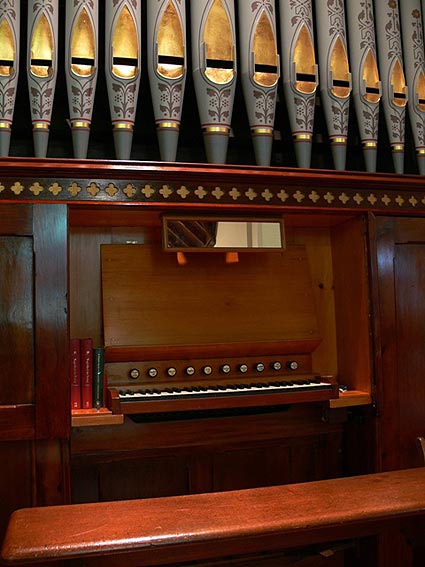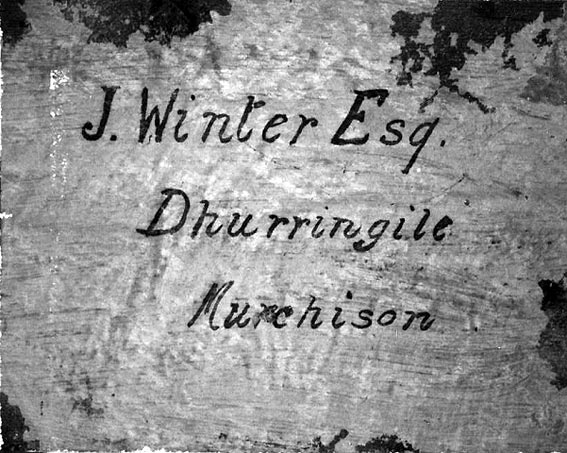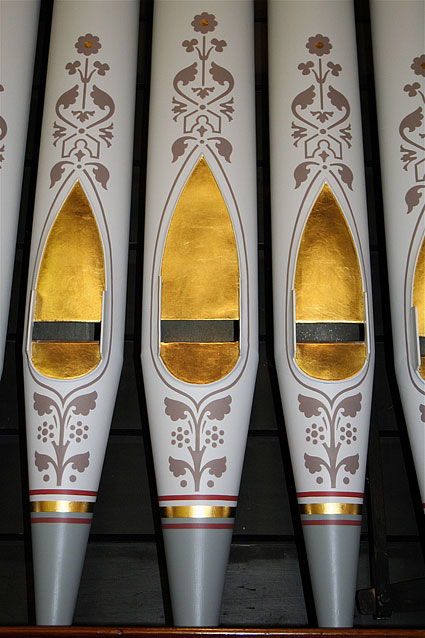Flinders, Victoria
B 1874 Douglas Renton
inst present loc. 2005 from Elsternwick Baptist Church
1 manual, 9 speaking stops, 1 coupler, mechanical action

Photo: Trevor Bunning (Oct. 2008)
The Church of St John-the-Evangelist, Flinders was dedicated on 28 January 1892. The building was designed by architect William Barker and was constructed in brick in the Gothic style. The original building consisted of nave of four bays, western porch and a small sanctuary. On 11 June 1935, major additions to the church were dedicated. These consisted of transepts, sanctuary and vestry, all designed by architect George Smith. (Ruth Carter, The Anglican Church of St John the Evangelist Flinders 1892-1992, pp.5, 11)
The pipe organ that was installed in St John's in 2005 has a long history, with earliest records dating back to 1874 when it was installed at the Presbyterian Church, Williamstown and opened there with a sacred concert on 22 January 1874. The Williamstown Chronicle, 24 January 1874, p.5 recorded:
The organ contains one manual and two octaves of pedals. Its compass ranging from CCC to GG. And contains eight stops. It also possesses a Bourdon pedal. There is a coupler manual attached to the pedals, the whole, except the Bourdon and open diapason front pipes, being enclosed in a swell box. The case is plain, of stained deal, varnished, and the front pipes gilded. It is erected behind the pulpit, and forms a very handsome backing for the same. The whole cost, including its erection in the church, amounts to about £300. The quality of tone of the instrument is very fine, being mellow and round, and though of not great power, still quite sufficient to fill the church. The instrument was supplied by Messrs. Wilkie, Webster, and Allan, and was built for that firm by Mr Renton, one of the gentlemen who came out in charge of the Melbourne Town Hall organ.
An inscription on the organ before 1987 recorded that it had been installed at Williamstown on 21 January 1874 by J. Jones.
This is likely to be the only surviving Australian organ built by Douglas Renton, who was a Scottish organbuilder who settled briefly in Melbourne before returning to Scotland in the mid-1870s. Renton also appears to have built a second small organ for Wilkie, Webster and Allan that was initially located in the Congregational Church, Howe Crescent, South Melbourne opened in March 1872 and later in the Presbyterian Church, Richardson Street, Albert Park before being broken up c.1970. The reservoir of this organ was marked with Renton's name. The Flinders casework, with its posts and finials and quatrefoil decoration of the impost and transom rails, and its tonal design, is virtually identical with other organs built by Melbourne organbuilder William Anderson and it seems highly likely that Anderson had some role in the building of this instrument, maybe manufacturing many of its parts on a sub-contract basis.
In 1882 a new Fincham organ was installed at Williamstown and the earlier organ moved by Fincham in July 1882 to 'Dhurringile', near Murchison, Victoria, a large mansion owned by J. Winter. A spotted metal Angelica appears to have replaced the original Twelfth at this time. An organ in this residence is mentioned by William Bossence in his book Murchison, page 20. The mansion was later owned by the Hon Robert Harper, MLA (personal communication the Revd David Poole to John Maidment 1987; Fincham letter books 23 May 1919).
In 1919 it was installed by George Fincham & Son at Kew Baptist Church for £110 (Jill L. Manton, A History of Kew Baptist Church: the first 125 years. Kew: the church, 1981, p.26; Fincham letter books 23 May 1919) and in 1923 it was moved to the new church in Highbury Grove, Kew - "the organ repaired, dismantled and installed in the new church", opened 9 June 1923 (Manton, p.30). An electric blower was installed in 1932.
In 1938, the organ was sold to Elsternwick Baptist Church for a sum of £80. It was installed by C.W. Andrewartha, of Caulfield, who had built a new organ for the Kew church in the same year. In 1987 the organ was partially restored by S.J. Laurie Pty Ltd. The bellows gussets were replaced, feeders removed, windchest and action overhauled, console repolished, and the façade pipes resprayed in gold.
The organ was moved in September 2005 to St John's Church, Flinders, a small historic township at the entrance to Western Port Bay. The work has been assisted by an OHTA-sponsored restoration appeal. As the Elsternwick church had been auctioned earlier in 2005, the organ had become redundant. The instrument was in excellent shape apart from some borer infestation, which was addressed, and some deterioration of roller arms and glued joints. The casework, covered in 'Estapol antique' has been cleaned back and repolished. The organ has been installed in a diminutive south transept, providing an excellent home for the instrument. The restencilling of the facade pipes by Marc Nobel was completed in October 2006 utilising patterns and colours from the facades of the William Davidson organ at St Paul's Anglican Church, Burwood, NSW.

The specification is as follows:
| MANUAL Open Diapason Stopped Diapason Bass Clarabella Dulciana Principal Flute Angelica Fifteenth Manual to Pedals PEDAL Bourdon |
8 8 8 8 4 4 8 2 16 |
bottom 16 zinc in façade (one central dummy) CC-TB MC gvd bass TC replacing original Twelfth |
Compass: 56/25
4 composition pedals
lever swell pedal
tremulant (later addition)
 |
 |
|
 |
 |
|
 |
 |
|
|
After the restencilling of the façade pipes |
Before the restencilling of the façade pipes |
|
 |
||
 |
||
Photos: JRM 2006


2 photos above: Trevor Bunning (October 2008)